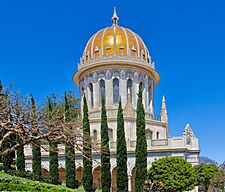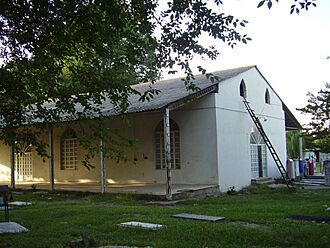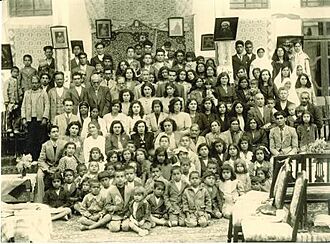Bábism facts for kids
Quick facts for kids Bábism |
|
|---|---|

Shrine of the Báb in Haifa, Israel
|
|
| Type | Messianic movement |
| Classification | Abrahamic, Iranian |
| Theology | Monotheistic |
| Founder | The Báb |
| Origin | 1844 Qajar Iran |
| Members | 1,000–2,000 |
Bábism (Persian: بابیه, romanized: Bâbiyye) is a religious movement that began in 1844. It was founded by the Báb (born 'Ali Muhammad), who was a merchant from Iran. The Báb taught that there is one God who is beyond our understanding. This God shows His will through special messengers, called Manifestations of God.
The Báb's time as a prophet was short and difficult. He was publicly executed in Tabriz in 1850. After his death, many of his followers were killed. This period is known as one of the bloodiest actions by the Qajar Iranian military in the 1800s.
Today, Bábism has only a few thousand followers, mostly in Iran. However, it continued through the Baháʼí Faith, which most Bábís later joined. Bahá'ís believe Bábism was a step before their own religion. The remains of the Báb were secretly moved over many years. They were finally buried in 1909 at the Shrine of the Báb in Haifa, Israel.
Contents
What Does "Bábism" Mean?
The name Báb (lit. Gate) refers to a "gate" to the Twelfth Imam. The word Bábism comes from the Arabic word bāb, meaning "gate." This term was first used by people studying Eastern cultures, not by the followers themselves.
History of Bábism
Before Bábism Started
Twelver Shia Muslims believe in twelve spiritual leaders called Imams. They believe the last Imam, Muhammad al-Mahdi, disappeared in 874 CE. During his "Minor Occultation," people could only communicate with him through special mediators called "bābs" (gates). Later, in 940 CE, the last mediator said the Imam had gone into an "indefinite" hiding.
Shia Muslims believe this Hidden Imam is still alive but hidden from his enemies. They believe he will return before the Last Judgment. When he returns, he will be known as the Mahdi and will bring justice to the world.
In the 1830s in Persia, Kazim Rashti led a group called the Shaykhis. They were expecting the Mahdi to appear soon. Before Kazim's death in 1843, he told his followers to search for this promised leader.
How Bábism Began

On May 22, 1844, Mullá Husayn, a student of Sayyid Kāẓim, arrived in Shiraz. He was looking for the promised leader. That night, the Báb invited Mullá Husayn to his home. The Báb told Mullá Husayn that he was the successor to Sayyid Kāẓim and had special divine knowledge.
Mullá Husayn became the first person to accept the Báb's claims. The Báb answered all his questions and quickly wrote a long commentary on a chapter of the Qur'an. This writing, called the Qayyūmu l-Asmā', is seen as the Báb's first major work. This night is celebrated as a holy day in the Baháʼí Faith.
The Báb told Mullá Husayn to wait until 17 other people independently recognized his spiritual rank. Within five months, seventeen more followers of Sayyid Kāẓim accepted the Báb. One of them was a woman named Zarrin Tāj Baraghāni, a poet who later became known as Táhirih (the Pure). These 18 disciples, along with the Báb, were called the Letters of the Living. They were given the job of spreading the new faith.
After this, the Báb took the title "the Báb." His movement quickly spread across Iran, causing much discussion. At first, some people thought he was just a "gate" to the Hidden Imam. But he later clearly stated that he was the promised Mahdi himself.
The Faith Spreads
The Báb's message was shared by the Letters of the Living throughout Iran and Iraq. News of the new religion reached the West in 1845 through diplomatic reports. As the Báb's followers spread his teachings, they faced growing opposition from Islamic religious leaders.
In June 1845, the Báb was arrested in Shiraz and placed under house arrest. He was later released and went to Isfahan, where many people came to see him. His popularity grew after he debated local clergy.
In January 1847, the Shah ordered the Báb to Tehran. However, the Prime Minister sent him to Tabriz, and then to Maku and Chehriq, where he was kept in prison. Even in prison, he impressed his jailers. It became harder for him to communicate with his followers, so the Letters of the Living took on more responsibility for spreading his teachings.
Táhirih played a very important role. She began to teach that the Báb's authority was higher than Islamic law. She even appeared in public without a veil, which was a very bold act at the time. This showed the clear separation of the Bábí movement from traditional Islam. This separation became very clear at the Conference of Badasht in 1848.
During this time, the Báb was put on trial in Tabriz. He publicly declared to the Crown Prince and the clergy that he was the Mahdi. By 1848 or 1850, some sources say there were 100,000 followers of Bábism.
Uprisings and Massacres
By 1848, the strong beliefs of the Bábís and the opposition from the clergy led to many conflicts. After the death of Mohammad Shah Qajar, the Shah of Iran, armed struggles broke out. These conflicts often resulted in the killing of Bábís. It is estimated that about 20,000 Bábís were killed between 1844 and 1864.
The first major killings happened in Qazvin. As attacks increased, some Bábís began to carry weapons for self-defense. Major conflicts took place in Babol, Zanjan, and Neyriz. While Bábís were accused of revolting, it seems their actions were mostly defensive. There is no clear evidence of a planned revolution. In mid-1850, a new prime minister, Amir Kabir, ordered the execution of the Báb. Many Bábís were killed after this.
Fort Tabarsi
One of the most famous conflicts happened in Māzandarān at the shrine of Shaykh Tabarsi. From October 1848 to May 1849, about 300 to 600 Bábís, led by Quddús and Mullá Husayn, defended themselves. They fought against local villagers and the Shah's army. After being weakened by hunger, they surrendered under false promises of safety. They were then killed or sold into slavery.
Zanjan Upheaval
The conflict in Zanjan was the most violent. It lasted seven or eight months, from May 1850 to January 1851. The Bábí community in Zanjan grew to about 3,000 people. Tensions had been building for years between the Islamic clergy and the Bábí leaders. The city governor divided the city, and fighting soon began. Thousands of Bábís were killed. After their leader, Hujjat, was killed, the remaining Bábís surrendered and were massacred.
Nayriz Upheaval
Another serious conflict happened in Neyriz in Fars. A Bábí leader named Yahya Vahid Darabi had converted about 1500 people. This caused tensions, leading to armed conflict at a nearby fort. The Bábís fought off attacks from the governor and reinforcements. In June 1850, after a truce offer, Vahid told his followers to give up. Vahid and many Bábís were then killed. Their homes were looted. Later, in 1853, more conflicts and massacres of Bábís occurred in the area.
After the Báb's Execution

While the conflicts in Zanjan and Nayriz were happening, the Báb was taken from his prison in Chehriq to Tabriz. He was publicly shot in front of the citadel in 1850. His body was later recovered by Bábís and secretly moved. Eventually, it was taken to Haifa, where it is now buried in the Shrine of the Báb.
After 1860, many Western scholars saw Bábism as a way to bring Western ideas into the Islamic world. Some even compared the Báb's impact to that of Jesus.
For the next two years, the Bábí community was divided. One group wanted revenge against the Shah, while another, led by Bahá'u'lláh, wanted to rebuild the community peacefully.
On August 15, 1852, a small group of Bábís tried to assassinate Naser al-Din Shah Qajar. Even though they acted alone, the entire Bábí community was blamed. A mass killing of thousands of Bábís followed, starting on August 31, 1852. Táhirih was among those executed. Bahá'u'lláh was imprisoned in the Siāhchāl ('Black Pit') dungeon in Tehran.
Bahá'í–Azali Split
In his writings, the Báb often spoke of a Promised One who would come after him. He called this figure "He whom God shall make manifest" and said he himself was only a "ring upon the hand" of this future messenger. Within 20 years of the Báb's death, over 25 people claimed to be this Promised One, with Bahá'u'lláh being the most significant.
Before his execution, the Báb appointed Subh-i Azal as the leader of the Bábís. However, Subh-i Azal was young and often stayed hidden. Bahá'u'lláh, his older brother, took on many of the daily tasks of leading the Bábí community.
Bahá'u'lláh claimed that in 1853, while in prison, he received a divine message. Ten years later, in Baghdad, he privately declared that he was "He whom God shall make manifest." He made this claim public in 1866. Bahá'u'lláh's claim challenged Subh-i Azal's leadership.
Most Bábís accepted Bahá'u'lláh's claim and became known as Bahá'ís. By 1908, there were many Bahá'ís, but only a few hundred followers of Subh-i Azal. Subh-i Azal died in Cyprus in 1912. His followers, known as Azalis, are now very few, mostly in Iran.
Bábí Beliefs and Teachings
The Báb's teachings developed in three main stages. First, he interpreted the Quran and Islamic traditions. Then, he explained the deeper meaning of existence. Finally, he gave new laws. All his teachings were based on a central idea that had many layers.
The Hidden Imam
In Twelver Shiʻa Islam, the last of the twelve Imams, known as Imam Mahdi, was believed to be hidden. Shia Muslims believe he will return to restore true religion.
In Bábí belief, the Báb was the return of the Imam Mahdi. However, the Báb taught that his appearance was a symbolic return, not the physical return of the Imam who had died long ago. He also said that he was not only the fulfillment of Shia prophecies but also the start of a new religious era.
Resurrection, Judgment Day, and New Revelations
The Báb taught that his revelation was ending the Islamic era and starting a new one. He explained that terms like "resurrection," "Judgement Day," "paradise," and "hell" in prophecies were symbolic. "Resurrection" meant the arrival of a new revelation. "Raising of the dead" meant people spiritually awakening to true religion. "Judgement Day" referred to when a new Manifestation of God appears, and people choose to accept or reject them.
The Báb wrote that religious teachings come in cycles, like seasons, to renew faith. This idea meant that more prophets would come after him.
He Whom God Shall Make Manifest
A central Bábí teaching is that a new prophet would soon appear. The Báb called this figure He whom God shall make manifest (Arabic: من يظهر الله). This figure would complete the revelation that the Báb began. The Báb described this future messenger as the source of all divine qualities.
The Báb's main book, the Bayan, focuses on this future messianic figure. The Báb always spoke of his own mission as preparing people for the arrival of this greater messenger. He urged his followers to seek out and recognize this Promised One for themselves. He warned them not to reject the new prophet, just as followers of past religions had rejected new messengers. The Báb also hinted that this Promised One would appear soon.
After the Báb's execution in 1850, Baháʼu'lláh claimed to be this figure in 1863. Most Bábís followed him and became Bahá'ís.
Religious Laws
The Báb changed Islamic law and introduced new Bábí laws in the Persian Bayán. This made Bábism a separate religion. Some new laws included changing the direction of prayer to the Báb's house in Shiraz. He also changed the calendar to a solar calendar with nineteen months and nineteen days. The last month was for fasting. The Báb also said that people should only confess and seek forgiveness from God and His Manifestation.
The Báb also improved the status of women. He taught that men and women are equal in God's eyes. He told his followers not to mistreat women and set a higher penalty for causing women grief. He encouraged education for women and did not separate genders in laws about learning. He also spoke of the "Maid of Heaven" as a female symbol of God's will.
The Báb also emphasized the need for fast and accessible news for everyone. He also taught that wealthy people should be like "depositories of God." He encouraged generosity and charity, saying, "Should ye find one stricken with poverty, enrich him to the extent of your ability."
The Báb also called for clean water and forbade selling the four elements: earth, air, fire, and water. He also introduced other rules, such as carrying weapons only when necessary, not smoking tobacco, and treating animals kindly. He also recommended printing books and abolished the need for a priesthood.
Some scholars believe that the Báb's strict laws were not meant to be fully put into practice. They think these laws were meant to prepare his followers for the arrival of "He whom God shall make manifest." These laws would only be kept if the Promised One chose to reaffirm them.
Báb's Writings
The Báb said that the verses revealed by a Manifestation of God are the best proof of their mission. The Báb's writings include over two thousand tablets, letters, prayers, and philosophical works. These writings are part of Baháʼí scripture.
The Báb's main writings include the Qayyúmu'l-Asmáʼ (a commentary on the Sura of Joseph) and the Persian Bayán. The Bábís believed the Persian Bayán replaced the Qurʼan.
Scholars have studied the Báb's writings. They note that his writings aimed to help readers break free from old beliefs. The Báb's works use many symbols, like numbers, colors, and parts of the human body, to reflect God's qualities. His writings also use new words and repeat important phrases.
The Báb said his writings were over five hundred thousand verses long. For comparison, the Qurʼan is 6,300 verses. Many of the Báb's writings have been lost. However, some of his major works are still available in the handwriting of his secretaries.
Most of his works were written in response to questions from his followers. Sometimes, the Báb would chant his writings very quickly in front of a secretary and witnesses.
The Baháʼí World Centre currently holds about 190 of the Báb's Tablets. Parts of his main works have been published in English in Selections from the Writings of the Báb.
See also
 In Spanish: Babismo para niños
In Spanish: Babismo para niños
- New religious movement
- Outline of Bábism
- Selections from the Writings of the Báb




